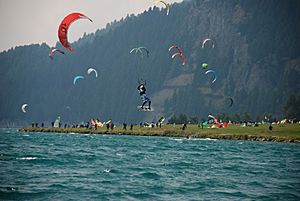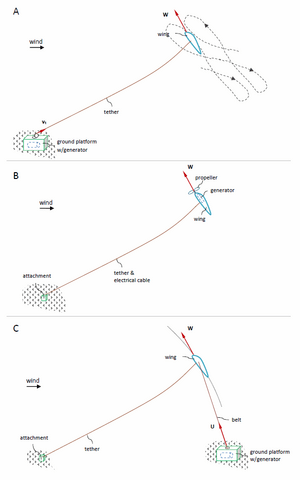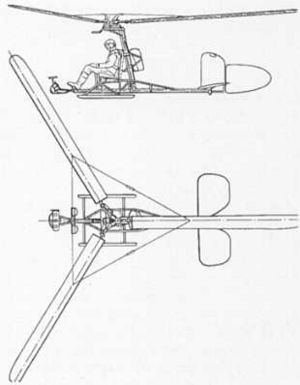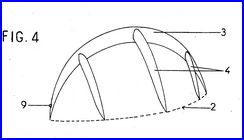Crosswind kite power facts for kids
Crosswind kite power is a way to get energy from the wind using special kites. These kites have parts that fly across the wind's direction, like a crosswind airplane. This helps them grab a lot of wind energy.
These systems can be small, like toys, or huge, big enough to power homes! They can be used to get wind power from high up in the sky or closer to the ground. The best part? They don't need tall towers like regular wind turbines.
Crosswind kite power systems can use flexible kites or stiff, airplane-like wings. A kite flying across the wind can move much faster than the wind itself. This allows it to collect energy from a much larger area than the kite's actual size.
These kite systems have some cool benefits over regular wind turbines. They can reach stronger, steadier winds. They can also work well both on land and in the ocean without costing a lot more. Plus, they don't need those giant towers.
Scientists like Miles L. Loyd studied crosswind kite power a lot, starting in 1980. People have actually used crosswind kite power for a long time, even for things like target practice for gunners, where the fast-moving kites helped train them.

Contents
- How Crosswind Kite Power Systems Work
- How Crosswind Kite Power is Controlled
- Challenges for Crosswind Kite Power
- The Future of Crosswind Kite Power
- Patents and Crosswind Kite Power
- Sizes of Crosswind Kite Power Systems
- A Quick Look at Crosswind Kite Power History
- What Makes a CWKPS Different?
- Images for kids
How Crosswind Kite Power Systems Work
Crosswind kite power systems (CWKPS) get energy from the wind in different ways. How they work helps us sort them into types.
One way to sort them is by where the main energy-making part (like a generator or pump) is located. Another way is how the ropes (called tethers) are used. Tethers can just hold the kite up, or they can pull things on the ground. They can even send electricity down to the ground!
Some systems move very fast, and others move more slowly. The type of wings used also matters. A system might have one simple kite or many kites linked together. CWKPS can also be sorted by their size, what they are used for, and how much they cost.
Some CWKPS are called "lifters." They are made just for lifting heavy things, even people! These often use spinning blades that look a bit like helicopter blades. A single CWKPS can even do two jobs at once, like making electricity while also pulling a load on the ground.
Scientists are also looking into systems that use "flutter." This is when a part of the kite wiggles very fast to create energy.
Kites That Pull People or Things
In this type of CWKPS, the kite's pulling ropes move people or objects across water, land, or even through the air. The way the people or objects resist the pull helps define more types.
The upper flying kites move across the wind to create power for different activities. This includes sports like Kiteboarding, kite windsurfing, and snowkiting. It also includes using kites to pull yachts, cargo ships, or even small boats.
Some researchers have looked at how kites flying across the wind could help people fly freely in the atmosphere. Imagine a kite system where a person is attached, and the kites fly across different wind layers to keep them soaring!
Kites That Turn Generators or Pumps
In these systems, an electric generator or pump is on the ground. The kite's movement helps power it. There are two main ways this works:
- "Yo-Yo" Method: The kite flies across the wind in a figure-8 or circular path. As it pulls, a rope slowly unwinds from a drum on the ground. This turning drum spins the generator or pump. When the rope is fully out, the kite is briefly "depowered" (made to lose lift), and the rope is reeled back in. Then the cycle starts again. Some systems use two ropes instead of one.
- With a Moving Vehicle: Here, the generator is on a moving vehicle like a carousel, a car on rails, or even a ship. The kite pulls this vehicle, and the vehicle's movement (like its wheels or propeller) spins the generator.
Kites With Generators Onboard
In this type, the electric generator is actually on the kite itself. The wind spins special blades on the kite, which then power the generator. The electricity made is sent down to the ground through a special cable built into the kite's rope.
Sometimes, these same blades can also act as propellers. This helps the kite launch, land, or stay flying when there isn't much wind.
Kites That Transfer Motion to the Ground
In this system, the generator is on the ground. A separate cable or belt trails behind the fast-moving kite. This belt transfers the power directly to a wheel on the ground, which spins the generator. Because the belt moves very fast, there's no need for a complex gearbox.
Kites With Upwind Ground Receivers
Here, the generator or pump is on the ground, but it's located upwind (in front of) the kite. The fast-moving kite, flying across the wind, uses two or more ropes to drive this ground-based system.
Lighter-Than-Air Assisted Kites
Some researchers are exploring systems where two kites work together. These kites use lighter-than-air devices (like small balloons) to help them stay flying, even if the wind dies down for a bit. They still pull loads on the ground that are upwind.
LTA-Assisted Turbines
Many ideas and current research focus on using lighter-than-air kites to hold spinning turbines. These turbines use the wind to power generators located on the kite. The electricity is then sent down to the ground.
Flutter-Based Kite Power Systems
Sometimes, a kite part is designed to "flutter," meaning it wiggles very fast back and forth across the wind. This fluttering motion can be used to create energy. While flutter is usually bad for airplanes, it can be useful in CWKPS.
The fast motion of flutter can be used in several ways:
- It can make sound, even music, or scare birds away.
- It can jerk ropes to drive loads and make electricity.
- It can pump liquids.
- If the fluttering part is made with magnets and coils, it can directly generate electricity as it wiggles.
Kites Used for Pulling (Traction)
CWKPS are often used to pull objects over ice, snow, land, or water. This can be for fun, sports, business, or even science.
Many types of kites fly across the wind to move people doing sports like kiteboarding, land sailing, kite surfing, and kite skiing. They also pull boats, yachts, and even large ships. For example, SkySails helps big shipping companies save fuel by using CWKPS to pull their ships.
Kites Used for Lifting
In this type of CWKPS, the fast-moving kite blades or wings use wind energy to lift heavy things. Sometimes the heavy load is right on the kite. Other times, the weight is spread along the kite's rope.
The military has used these kites, like rotary-wing kites that look like helicopters (but aren't). They were tethered to submarines and lifted an observer high up to look around. These kites could lift and move things over obstacles or save fuel for ground transportation.
Kites That Twist Ropes
In this system, spinning kites fly across the wind and turn rings around a main guiding rope. Since these rings are connected and tight, the twisting motion from the kites can be sent down to a generator on the ground. This method was the first to complete a special challenge in 2015.
How Crosswind Kite Power is Controlled
How a crosswind kite power system is controlled depends on what it's used for. For sports like stunt kiting or kiteboarding, a person controls the kite during the whole flight. Some early electricity-producing systems were also controlled by people.
But when these systems get very big, companies are building special devices to help people control them, or even fully robotic systems that fly on their own. Some simple CWKPS can even fly passively, meaning they just naturally toss left and right in the wind without any human or robot control.
New computers, sensors, and steering systems are helping to make CWKPS fully automatic. This means they can launch, fly, and land by themselves. This is important for large systems that aim to produce electricity for cities.
Challenges for Crosswind Kite Power
Some parts of crosswind kite power are already very successful. For example, the sport of low-altitude traction kiting (like kiteboarding) is popular and safe.
However, the bigger CWKPS that aim to produce electricity for large power grids face several challenges. They need to get permission to use airspace and land. Safety is always a big concern. They also need to work reliably in all kinds of weather, day and night, summer and winter. Finally, they need to prove they are cost-effective compared to other energy sources.
The Future of Crosswind Kite Power
People are very excited about the future of crosswind kite power. Over a thousand people are working on these systems, from small toys to huge power plants.
Some imagine a future where goods can be moved around the world without fuel, using CWKPS that are either connected to the ground or even fly freely. CWKPS could be used for toys, sports, industry, science, business, making electricity, sailing, and many other tasks.
For CWKPS to compete with solar energy, nuclear energy, fossil fuels, or regular wind power, they need to become cheaper and more widely known. As CWKPS improve, other energy sources will also keep getting better. We expect to see many new designs for kite systems that fly across the wind to get more power.
Patents and Crosswind Kite Power
Many ideas for crosswind kite power have been protected by patents. Some of these ideas are now available for anyone to use, while others are still protected. These patents are important for researchers and developers in the crosswind kite power community.
Sizes of Crosswind Kite Power Systems
Crosswind kite power systems come in many sizes. You can find them as toy power kites, serious sport kites, and experimental sizes. Researchers are also planning huge systems that could power entire cities.
Small toy systems are fun and fill the sky at kite festivals. Serious sport systems help athletes race and compete. Experimental systems are used to test new ideas and work towards those giant utility-scale systems.
A Quick Look at Crosswind Kite Power History
Crosswind kite power has been used in different ways throughout history. The devices that create this power have also changed over time.
It's important to know the difference between a simple kite that just sits in the wind and a kite system that flies across the wind to make much more energy. Here's a quick timeline of how crosswind kite power has been used:
- 2013: Google bought a company that was developing systems with generators on the kite. These kites flew in circles across the wind and could even use their blades as propellers to fly like an airplane when needed.
- 2012 (November): A company called NTS Gmbh showed off their X-wind (crosswind) kite power system. It used cars on rails pulled by kites to drive a generator on the ground.
- 2012 (Around): A company called Pacific Sky Power started selling a crosswind kite power system. It had turbine blades on the kite that spun to make electricity. It was small enough for one person to use.
- 2010 (Around): A French patent showed how to make electricity using a generator on a crosswind kite with spinning blades.
- 2009: The Airborne Wind Energy Industry Association (AWEIA) was formed to support all types of kite power systems, including crosswind ones.
- 1980s: Kiteboarders showed how to travel effectively against the wind using crosswind kite power techniques.
- Earlier: Crosswind kite power was used in military target practice. The fast-moving kites helped simulate enemy aircraft for gunners.
- 1980 (May–June): Miles L. Loyd published an important paper called "Crosswind Kite Power." He explained how flying kite wings across the wind could collect a lot of energy.
- 1820 (Around): George Pocock (inventor) showed how to control a kite system to fly across the wind and pull a vehicle very fast. Many people see him as a pioneer of using crosswind kite power for transportation.
What Makes a CWKPS Different?
Not all kite power systems are CWKPS. A CWKPS needs its energy-making parts to fly across the wind.
For example, a simple diamond kite that just flies straight downwind and pulls a generator on the ground is NOT a CWKPS. It's a "downwind kite power system" (DWKPS). Some researchers are working on powerful DWKPS, like systems that use parachutes opening and closing to drive generators.
Even some CWKPS, like those that fly in figure-8 patterns, could be made to work without flying across the wind, turning them into DWKPS. But systems that use spinning blades on the kite itself are always CWKPS.
Famous examples of non-CWKPS include Benjamin Franklin's legendary pond-crossing by kite, where he was simply pulled downwind. Also, Samuel Franklin Cody used kites to lift people, but his kites flew steadily downwind without crossing the wind.
Images for kids











